Link building without link reclamation—the process of getting back lost links—is like trying to fill a leaky bucket.
According to Ahrefs, around 7% of links disappear in the first year, and our data shows that it might be as many as 15-20% within the first few months.
Now, imagine that you’re building 250 links a year and lose 40-50 of them. At $300 a link, that’s $12-15k down the drain.
Not exactly spare change! And it delays reaching your goals by a couple of months.
In the article, you will discover:
- Common reasons for losing links
- How losing links can affect your SEO efforts
- How to find and reclaim lost links
Link Reclamation vs. Claiming Unlinked Mentions vs. Broken Link-Building
Before we get into the nitty-gritty of link reclamation, let’s clarify how it’s different from two other popular and often confused link-building strategies: unlinked brand mentions and broken link-building.
Link reclamation involves asking webmasters to restore outbound backlinks from their websites. Those are links that previously pointed to your site but have been removed for one reason or another.
In contrast, unlinked brand or product mentions were never linked before. So, there isn’t anything to restore: you’re asking the website owner to add a brand-new backlink.
Broken backlinks are links that did exist before but didn’t point to your site but somebody else’s. So, broken link-building is about asking the webmaster to replace a dead link with a live one to your website.
Common Types of Lost Links
Why do you lose backlinks? Here are the four most common situations.
Link removed
The first scenario is when the website owner intentionally removes the link to your site.
Why could this happen?
- Backlinks get removed during content updates. If your link still adds value to the updated article, you can reach out and ask for the link to be restored.
- Webmasters find more authoritative or relevant sources. You have a chance to reclaim it if you improve the quality of your content.
- The website policy on external links changes. If they remove all backlinks, there isn’t much you can do about it, so forget about it.
- A link to your website causes a conflict of interest, for example, if they’re in your competitor’s affiliate program or get sponsored by them.
301 redirect
301 redirects are used to send visitors (and search engine crawlers) to a new page or website location after you’ve changed its structure.
For example, you could set up 301 redirects if you’ve merged two pages together. In this way, you help users find the content and preserve the link equity.
There are two ways in which you can lose a link as a result of the 301 redirect:
- The webmaster changes the content of the page and removes the link in the process.
- You set up the redirect incorrectly, it gets flagged, and the webmaster removes it from the linking page.
In the second instance, it may be possible to reclaim the link by fixing the redirect chain and sending the webmaster the correct link. In the first one, it’s worth chasing it only if the page still mentions you.
404 error
You get a 404 error when you click on a link to a page that doesn’t exist anymore. It could have been removed or is experiencing technical difficulties.
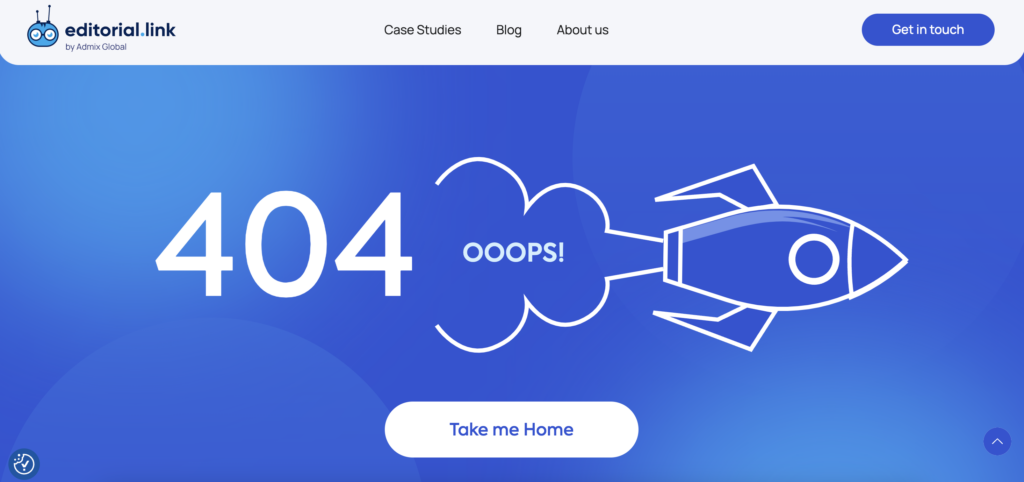
If the linking page disappears, there’s nothing to reclaim. You can look for similar content or unlinked mentions on the website and request a link from the owner, but technically, this isn’t a reclaim.
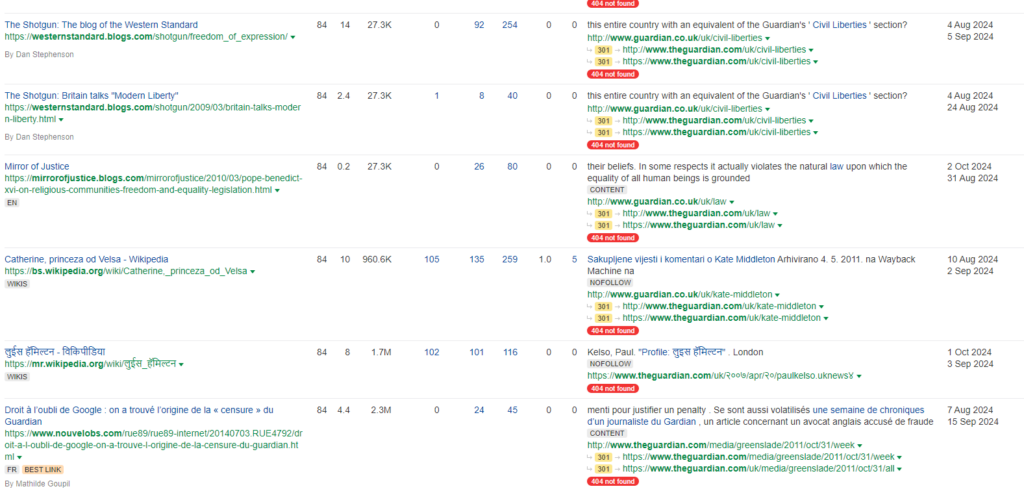
You may also lose a link as a result of a 404 error at your end. Dead links spoil the user experience on a page, so webmasters remove or replace them rather swiftly. If the page is back in action, you may still reclaim the link.
Linking page isn’t indexed
The final type of lost link is when the owner sets the linking page or domain attribute to ‘noindex.’ Whether it’s intentional or accidental, it removes it from the search engine’s index.
In this situation, the link is still on the page, but it passes no link equity.
Other possible reasons
If you’re using SEO tools like Ahrefs, they can mark your links as lost for a few more reasons:
- Not canonical anymore
- Crawl error
- Dropped
In all the instances, there’s no issue at all. Whether the canonical has changed, the SEO tool couldn’t crawl the page, or decided to remove it from its index, it doesn’t mean the link isn’t there.
And if it is, Google can still see it.
Why Reclaiming Link is Important?
Reclaiming links should be an inherent part of your SEO strategy, and you should allocate resources for that in your link-building campaigns.
Why?
Picture this:
You’ve conducted competitor analysis, and you can see that you need 500 backlinks from DR40+ domains with monthly traffic over 1000 to hit the top 3 spot in SERPs.
Considering the optimistic link decay rate of 7%, you’d actually need to build 535 links if you decide not to pursue the lost ones. That’s another 1-2 months, during which your competitors will also be building new links.
Now imagine that your article reaches the coveted #1 place in search engine rankings.
Well, you won’t stay at the top for long if you keep bleeding links and don’t replace them.
And what do you think is going to cost more, acquiring new links or reclaiming the lost ones?
Acquiring new ones, of course.
If the link was removed as a result of a technical glitch or mistake and the website still mentions you, this should take little effort compared to prospecting new sites, outreach, and negotiations.
Lost links aren’t just about lost link juice but also referral traffic.
The 15 Best Project Management Tool round-up on The Digital Project Manager, currently sitting in the #2 spot for ‘best project management tools,’ gets 44.5k organic visits every month.

If you’re one of the listed tools, the link can send thousands of potential customers shopping for a project management tool to your website.
Losing them would be much more painful than the link equity, even from a website with such high domain authority.
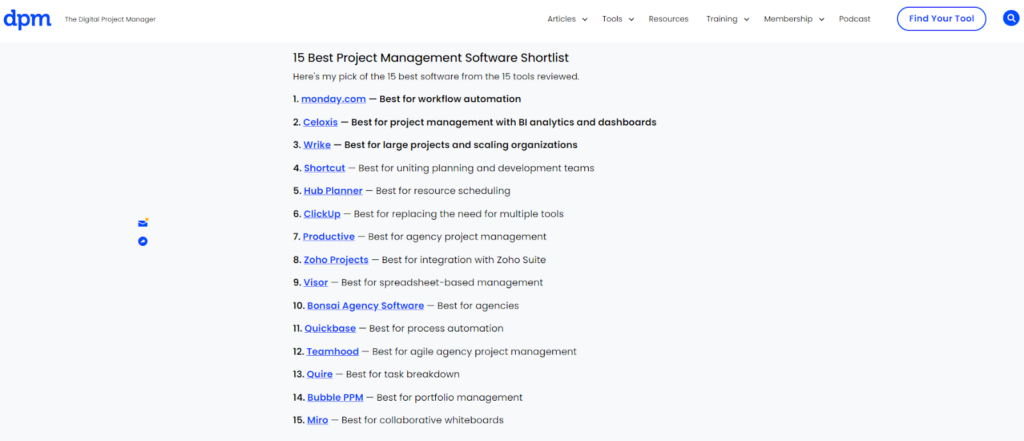
How to Find and Reclaim Lost Backlinks?
With the basics covered, let me take you through the process of reclaiming lost links.
Check your lost backlinks
The first step in the process is finding the lost links.
There are two ways to find them.
You can inspect your backlink profile for lost links in the Ahrefs Backlinks report. Filter the results by Lost and job done.
Here’s what it looks like for Backlinko, a well-known site in our niche with thousands of backlinks.

For example, here’s a link lost as a result of a 301 redirect.

And here is one which was removed from the referring page.

Alternatively, you can use a dedicated link monitoring tool like BacklinkManager.io or Monitor Backlinks.
These apps notify you of lost links via email alerts every 24 hours, so you never lose track of the lost links and can reclaim them as soon as they disappear.
Vet lost backlinks
Let’s face it: If you have a large website with thousands of backlinks, pursuing all lost backlinks isn’t feasible. To allocate your resources to reclaiming the most valuable links, vet them.
Filter the linking pages
Start the vetting process by sifting out all pages with low metrics.
Like the ones here.

These, on the other hand, are high-value links from a DR72 domain, and I’d very much like them back:

During my link reclamation process, I focus on links from domains with DR40+, 1K+ traffic, and in English.
Setting the filters in Backlinks report in the Ahrefs Site Explorer takes 3 seconds. At most.

Categorize the links
Next, categorize the links based on the reason why they disappeared. As mentioned, not all of them can be reclaimed.
There are two main ways to do it. You can either export all links to a spreadsheet and filter them there.
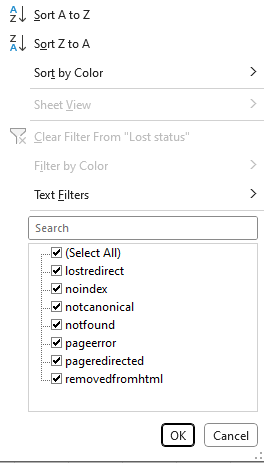
Or use Ahrefs filters:
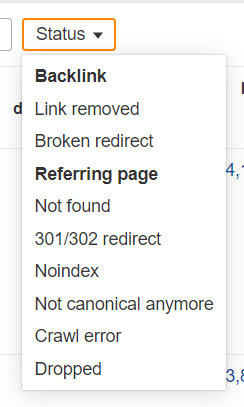
There’s also a 3rd way, which I’m going to use:
First, use the filters in Ahrefs and then export three lists to the spreadsheet, one for each type of lost link:
- Removed links
- 301 redirects
- Noindex
Next, I work my way through each list to identify the exact reason why the link is gone in Ahrefs and update each spreadsheet as I move along.
Organize the removed links
If the webpage has changed its policy on external backlinks, there isn’t much you can do about it.
You can check this by manually inspecting the page or its Outbound links in Ahrefs.
For instance, if your link was removed from this Backlinko article, it wasn’t because of a change of policy. The page still links to the other tools in its roundup.
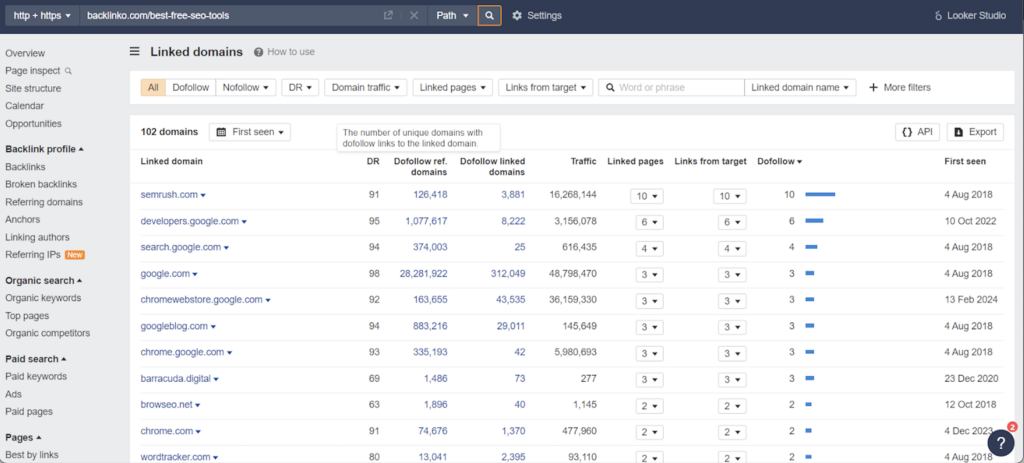
If your product is a direct Semrush competitor, this could be the reason, as they now own Backlinko.
You can find potential conflicts of interest by filtering the website’s outgoing links by the rel=sponsored attribute.

How can you tell if a link was lost to a content refresh?
1) Head to the Backlinks report and use the Status filter to view removed links (Link removed).
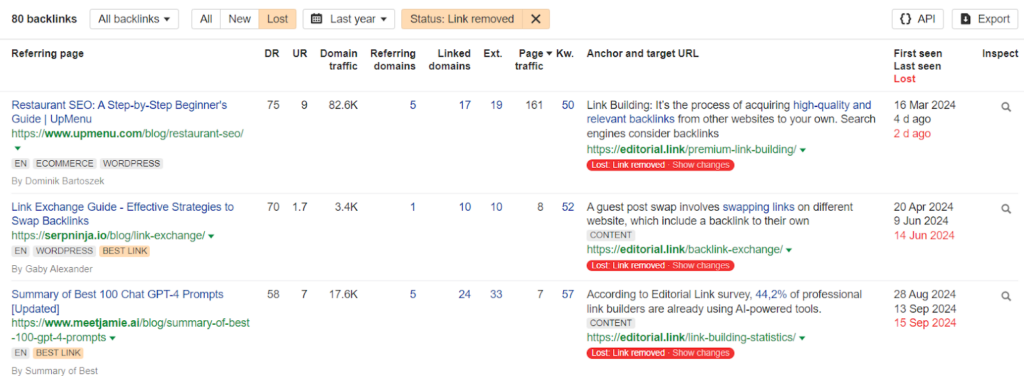
2) Click on the red Lost: Link removed - Show changes button. This opens the Page inspect window, where you get a side-to-side comparison of the relevant page code sections before and after the link was removed.
The more red on the page, the more changes were made, which could indicate an update.

In this particular case, you will see that the backlink wasn’t relevant. In a sentence about guest posting, they linked to our guide to link exchanges.
They replaced it with an internal link to their own relevant article, so the chances of getting it back are slim.
Check the 301 redirects
Links that show in Ahrefs as lost because of 301 redirects don’t need to be lost because the new page usually contains the link and, consequently, passes the link equity.
Here’s an example of such a redirect.

Although the link is showing as lost, the page still contains a link to our article:

So you don’t have to do anything. And that’s why I look at these links after I tackle the removed ones.
Having said that, sometimes the link is truly lost because the page was changed during the redirect. For example, the editor might have merged two blogs, and your link didn’t make the cut.
If that’s the case, check the page’s outbound links. If there’s no link, search for your brand mentions. If there is one, you have a chance to get it back.
Investigate noindex pages
Link from ‘noindex’ pages offer no SEO benefits, so chasing them is pointless. That’s if this attribute was added intentionally.
But what if it happened accidentally?
You can tell that it might be the case if the page has otherwise been optimized for search or when the homepage is ‘noindex,’ too.
There are plenty of free tools around that can check it for you. Use Google to find them.
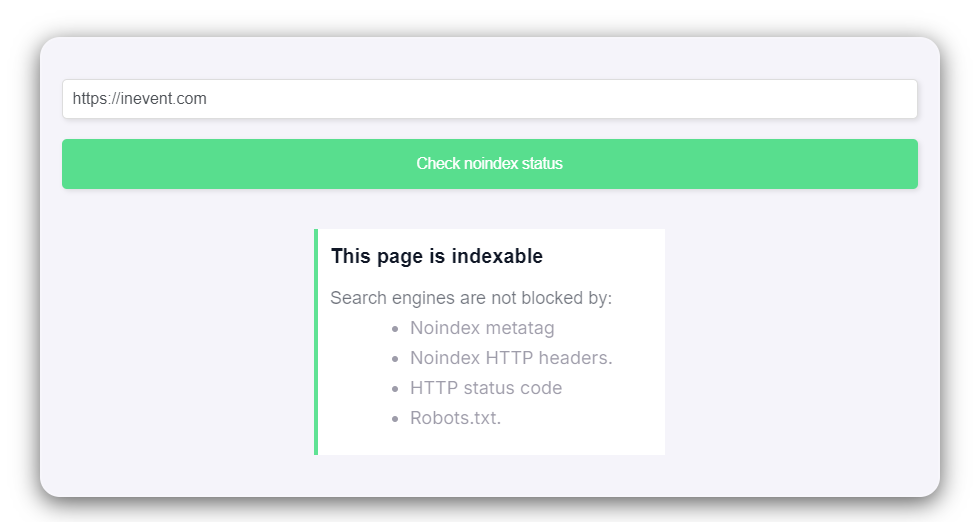
If the homepage is noindex, you can get the link back by letting the website owner know. They’ll definitely appreciate it.
However, they should figure it out themselves sooner or later without your help.
That’s why ‘noindex’ lost links are the last ones on my priority list.
How to reclaim lost links?
Got your prospect lists ready? It’s time to claim the links back.
Collect contact details
The easiest way to find the contact details is with tools like Hunter.io.
Thanks to Hunter’s Bulks feature, you can find email addresses associated with multiple domains you’re targeting in your campaign with a few clicks.
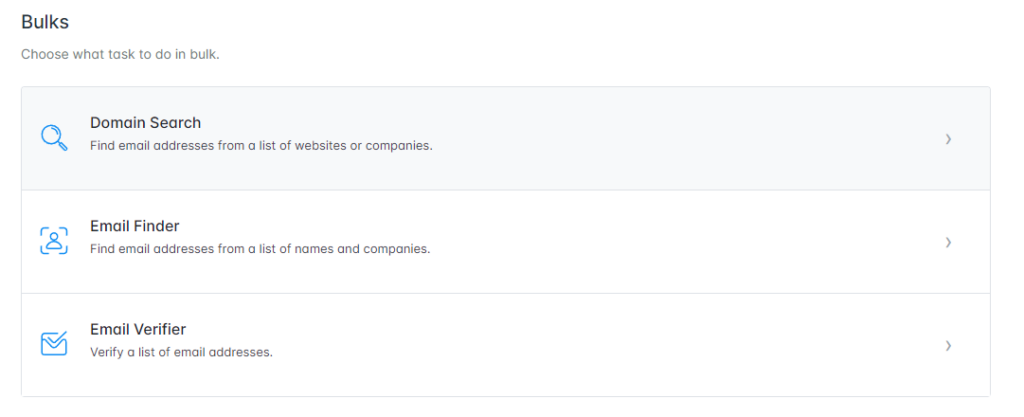
Just create a new bulk by adding domain/company names or uploading a list in a CSV, Excel, or TXT file.
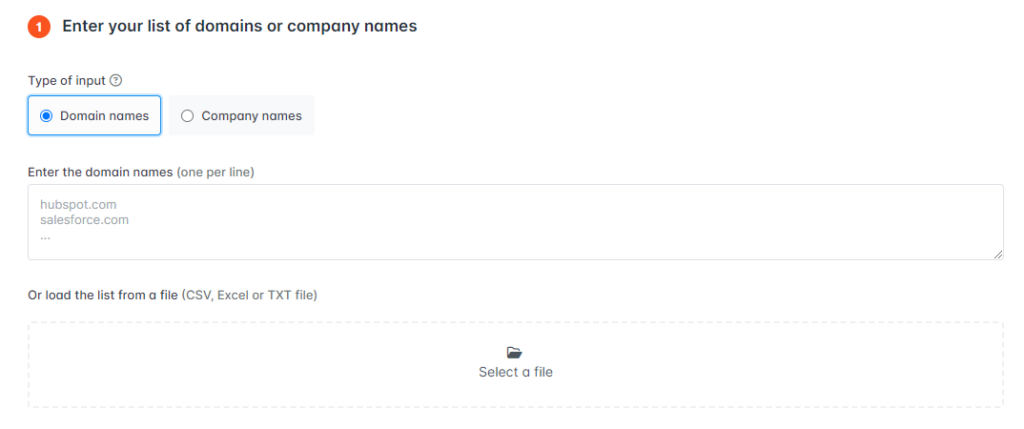
Next, set the filters and options.
You want personal email addresses from the Marketing and Writing & Communication departments only. That’s where the decision-makers are most likely to work.
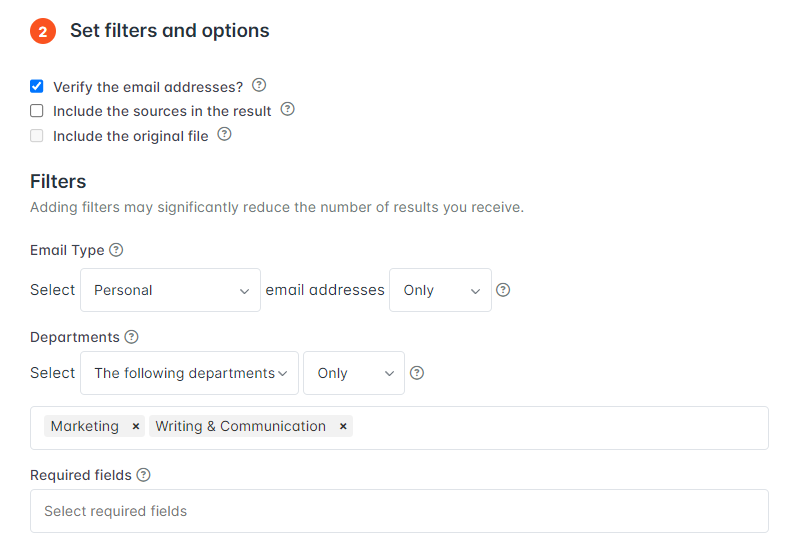
Alternatively, you can look for editors, heads of marketing/content, or SEO managers working for the companies on LinkedIn, create the list manually or export it from the Sales Navigator, and upload it to Hunter’s Bulk Email Finder.
The process is more time-consuming, but you have a better chance of finding the person responsible for link building.
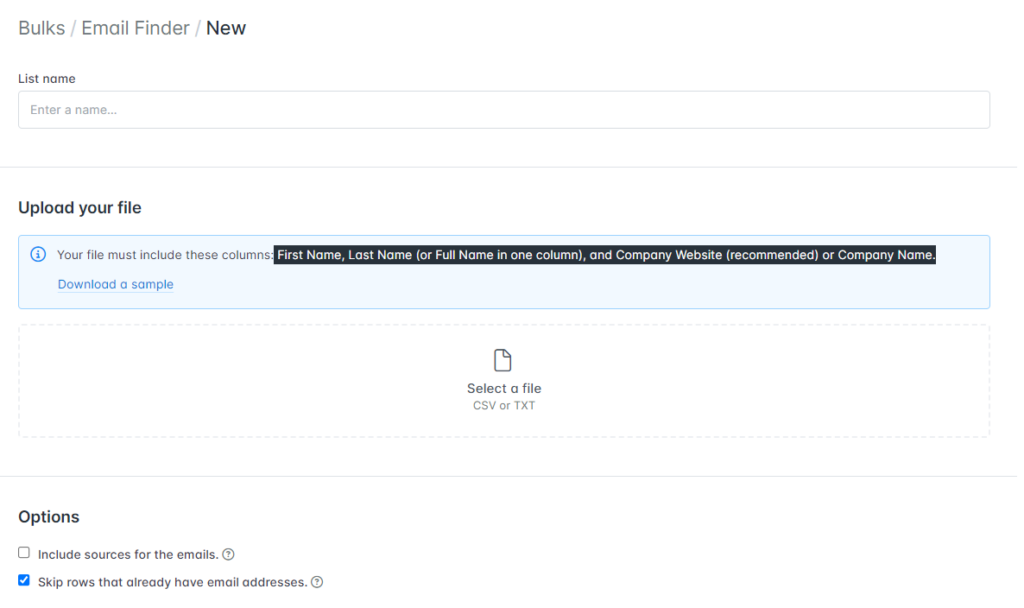
Craft the outreach emails
How you approach the webmasters depends on the reason why the link was lost.
Here’s a template that you can use to reclaim links lost as a result of updates or 301 redirects.

What if your link was replaced with another one?
Try this:
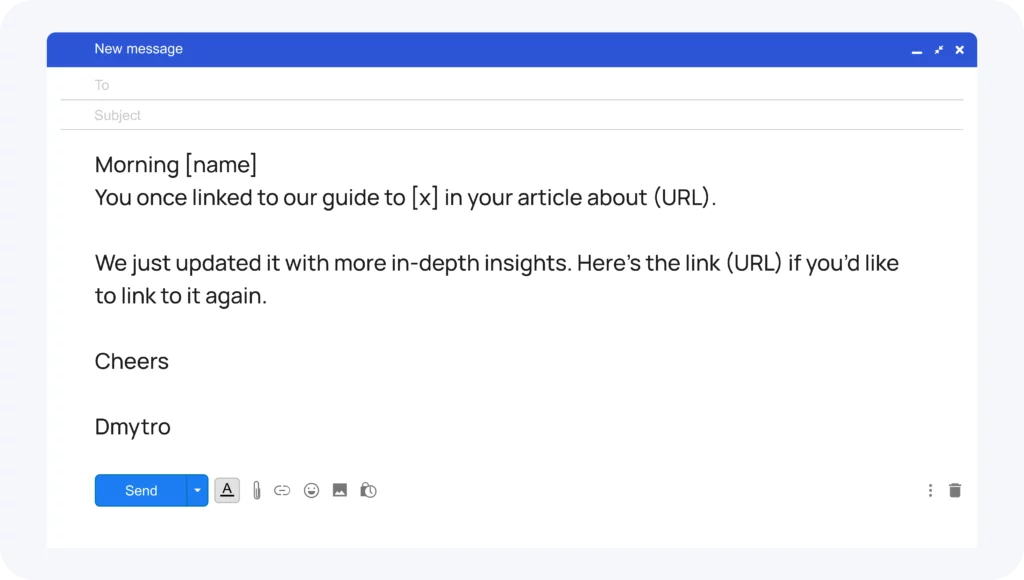
If the website or webpage is set to noindex, try this template.
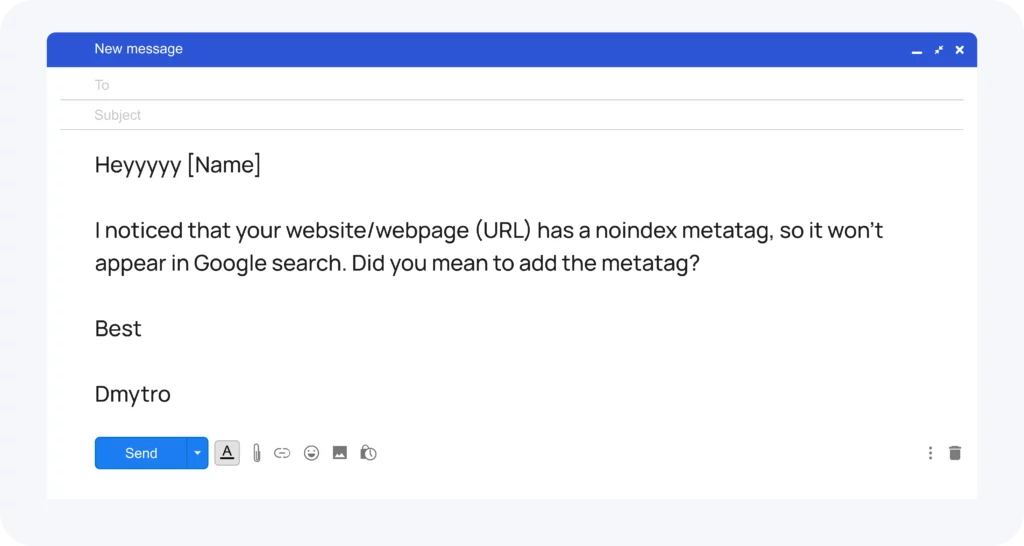
In your emails, be specific, use short sentences and paragraphs, and get straight to the point.
If possible, offer value upfront without asking for anything directly, like in the second and fourth messages. I only suggest improvements, and if the owner implements them, I get the link anyway.
Check the site manually and follow up
There’s a chance that you may never hear back from the website owner. It doesn’t mean they don’t add the link you’ve asked for.
Give them a week or so and check the page manually to see if they’ve updated it.
If not, follow up with another quick email.
You don’t need to be super creative here. They linked to you in the past, so there’s no need to convince anyone about the value that your link offers. Just restate your request.
Final Words
Losing your hard-earned backlinks is expensive and hinders your progress toward your SEO and business goals. It takes much more time and effort to acquire new links than to reclaim ones, so link reclamation is a vital component of every successful link-building campaign.
If you’re wondering how to incorporate link reclamation efforts into your SEO strategy or would like to outsource it to a reputable link-building agency, get in touch with the Editorial.Link team!

